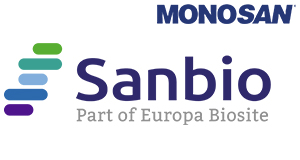Polyclonal antibody against GLUT1
Polyclonal antibody against GLUT1
Artikelnummer
SANPS317
Verpackungseinheit
1 ml
Hersteller
Sanbio / Monosan
Verfügbarkeit:
wird geladen...
Preis wird geladen...
Immunogen: Unknown or proprietery to MONOSAN and/or its suppliers
Concentration: n/a
Storage buffer: Tris Buffer, pH 7.3-7.7, containing 1% BSA and <0.1% Sodium Azide
Additional info: Glucose transporter type I (GLUT1), a prototype member of GLUT super family, reacts with a 55 kD protein, is a membrane-associated erythrocyte glucose transport protein. It is a major glucose transporter in the mammalian blood-brain barrier, and also mediates glucose transport in endothelial cells of the vasculature, adipose tissue and cardiac muscle. GLUT1 is detectable in many human tissues including those of colon, lung, stomach, esophagus, and breast. GLUT1 is overexpressed in malignant cells and in a variety of tumors that include the breast, pancreas, cervix, endometrium, lung, mesothelium, colon, bladder, thyroid, bone, soft tissues, and oral cavity. Immuohistochemical detection of GLUT1 can discriminate between reactive mesothelium and malignant mesothelioma. Anti-GLUT1 with anti-Claudin1, and anti-EMA are “perineurial” markers in diagnosis of perineuriomas. Anti-GLUT1 is also useful in distinguishing benign endometrial hyperplasia from atypical endometrial hyperplasia and adenocarcinoma. GLUT1 expression has been associated with increased malignant potential, invasiveness, and a poor prognosis in general. Expression of GLUT1 is a late event in colorectal cancer and expression in a high proportion of cancer cells is associated with a high incidence of lymph node metastases.
References: Kato Y, et al. Mod Pathol. 2006; 20:215-20/Afify A, et al. Acta Cytol. 2005; 49:621-6/Parente P, et al. J Exp Clin Cancer Res. 2008; 27:34
Concentration: n/a
Storage buffer: Tris Buffer, pH 7.3-7.7, containing 1% BSA and <0.1% Sodium Azide
Additional info: Glucose transporter type I (GLUT1), a prototype member of GLUT super family, reacts with a 55 kD protein, is a membrane-associated erythrocyte glucose transport protein. It is a major glucose transporter in the mammalian blood-brain barrier, and also mediates glucose transport in endothelial cells of the vasculature, adipose tissue and cardiac muscle. GLUT1 is detectable in many human tissues including those of colon, lung, stomach, esophagus, and breast. GLUT1 is overexpressed in malignant cells and in a variety of tumors that include the breast, pancreas, cervix, endometrium, lung, mesothelium, colon, bladder, thyroid, bone, soft tissues, and oral cavity. Immuohistochemical detection of GLUT1 can discriminate between reactive mesothelium and malignant mesothelioma. Anti-GLUT1 with anti-Claudin1, and anti-EMA are “perineurial” markers in diagnosis of perineuriomas. Anti-GLUT1 is also useful in distinguishing benign endometrial hyperplasia from atypical endometrial hyperplasia and adenocarcinoma. GLUT1 expression has been associated with increased malignant potential, invasiveness, and a poor prognosis in general. Expression of GLUT1 is a late event in colorectal cancer and expression in a high proportion of cancer cells is associated with a high incidence of lymph node metastases.
References: Kato Y, et al. Mod Pathol. 2006; 20:215-20/Afify A, et al. Acta Cytol. 2005; 49:621-6/Parente P, et al. J Exp Clin Cancer Res. 2008; 27:34
| Artikelnummer | SANPS317 |
|---|---|
| Hersteller | Sanbio / Monosan |
| Hersteller Artikelnummer | PS317 |
| Verpackungseinheit | 1 ml |
| Mengeneinheit | STK |
| Reaktivität | Human |
| Klonalität | Polyclonal |
| Methode | Immunohistochemistry (paraffin) |
| Wirt | Rabbit |
| Konjugat | Unconjugated |
| Produktinformation (PDF) | Download |
| MSDS (PDF) |
|

 English
English







